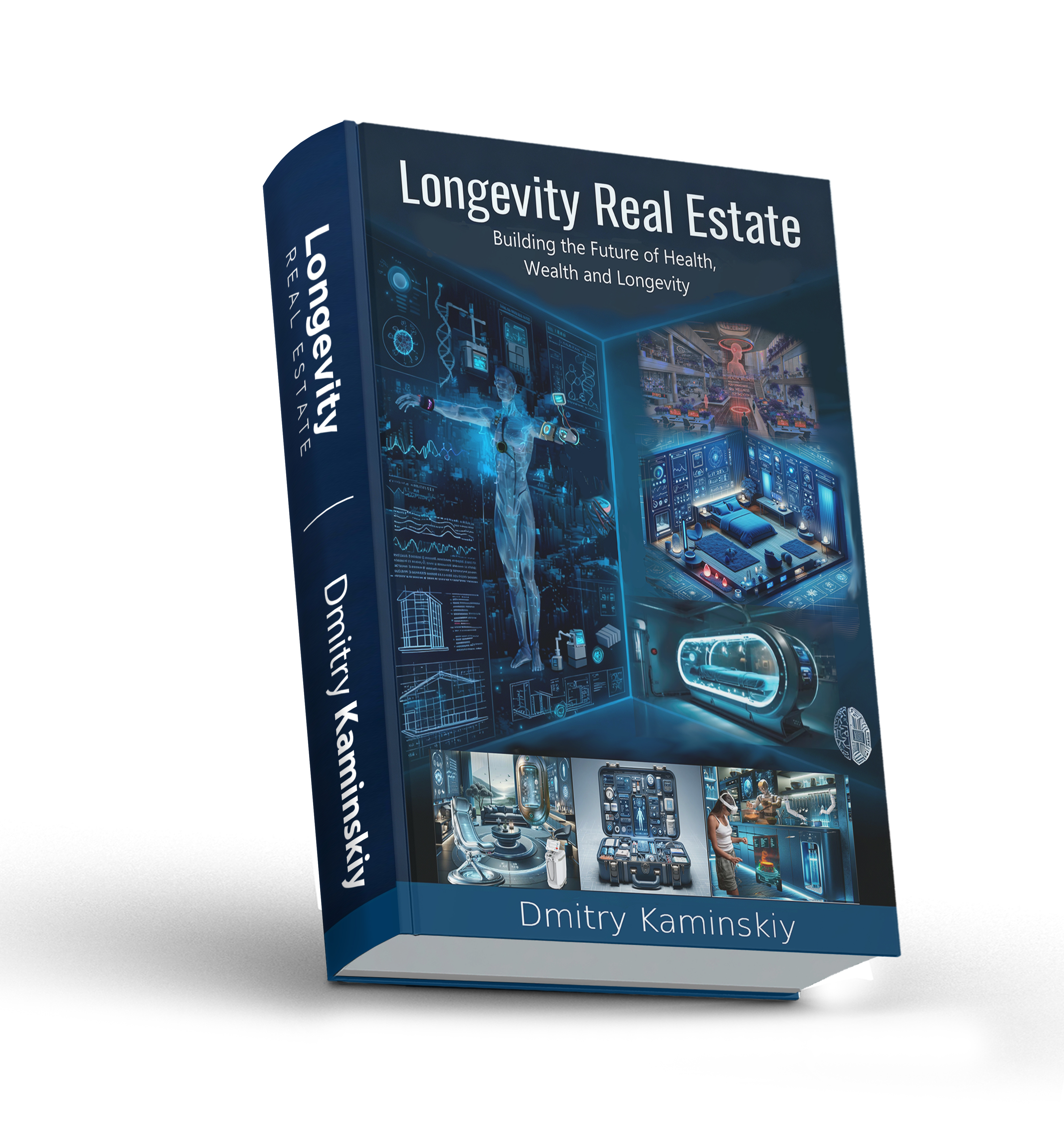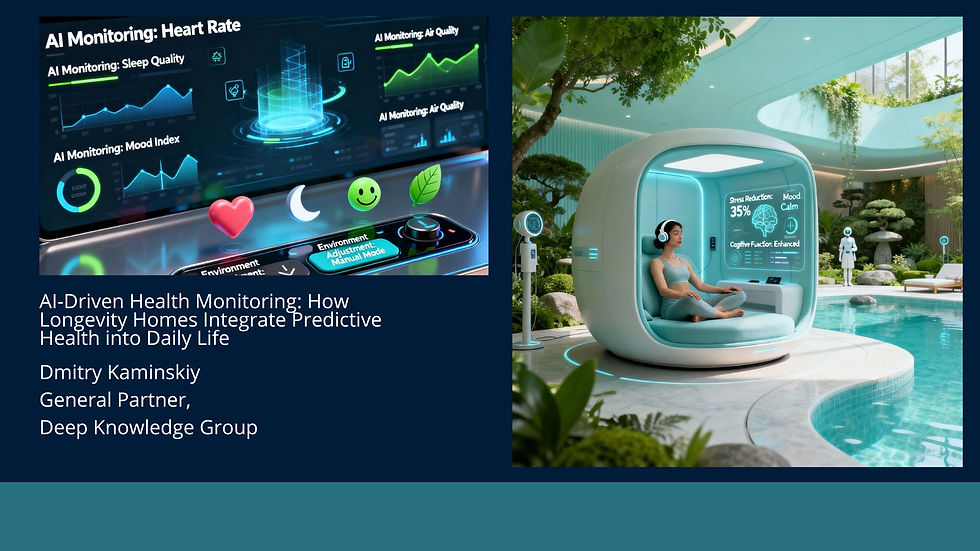AI-Driven Health Monitoring: How Longevity Homes Integrate Predictive Health into Daily Life
- Longevity Real Estate

- Oct 14
- 4 min read
Updated: 5 days ago

In the emerging Longevity Economy, the home is no longer a static space—it is becoming an active biological interface. Longevity Real Estate (LRE), as envisioned by Deep Knowledge Group, represents a new class of real estate designed not merely for comfort or sustainability, but for measurable extensions of human healthspan and performance. At the heart of this transformation lies one of its most revolutionary components: AI-driven health monitoring.
From Smart Homes to Living Health Systems
Traditional smart homes automate lighting or temperature. Longevity homes automate health. Equipped with biosensors, AI Co-Pilots, and digital twins, these environments continuously track residents’ biometric data—heart rate variability, glucose levels, sleep architecture, stress markers, and even cognitive load—and dynamically adjust conditions to support biological stability and resilience.
Walls, floors, and furnishings become part of a sensorial ecosystem, continuously collecting and interpreting data through embedded AI. The result is a form of “predictive living”—a concept defined in Deep Knowledge Group’s Longevity Real Estate framework—where the home anticipates health needs before symptoms arise.
For example, if a resident’s wearable or ambient sensors detect early markers of fatigue or metabolic imbalance, the AI system may subtly modify air ionization, lighting spectrum, or room temperature to rebalance circadian and hormonal rhythms. In doing so, the home becomes not just a setting for life, but a co-regulator of physiology.

The AI Co-Pilot: Personal Physician, Environmental Engineer, and Longevity Companion
Each resident in an LRE ecosystem is paired with an AI Co-Pilot—a continuously learning algorithmic companion embedded in the home’s infrastructure. Drawing from longitudinal biometrics and behavioral data, it learns the resident’s unique biological “baseline” and dynamically optimizes environmental and lifestyle parameters.
This system interfaces seamlessly with digital twins—virtual models of both the resident and the building—allowing in silico testing of interventions. The AI Co-Pilot can simulate outcomes of changes in diet, sleep schedule, or environmental exposure, and fine-tune its recommendations accordingly. This creates a closed feedback loop between biology, architecture, and intelligence, where every adjustment is evidence-based and personalized.

Real-Time Biometric Integration
Unlike periodic medical checkups, Longevity Real Estate’s health monitoring is continuous and unobtrusive. Biosensors embedded in furniture, flooring, or mirrors capture real-time physiological data, while wearables and smart fabrics feed complementary insights. These inputs allow for immediate micro-adjustments:
A drop in heart rate variability triggers calming light and soundscapes.
Elevated cortisol levels prompt AI-guided breathing or hydration cues.
Detected sleep disturbances lead to adaptive bedding temperatures and acoustic tuning overnight.
This convergence of architecture and AI represents a shift from healthcare as a service to healthcare as an environment.
Predictive Health at Scale: From Homes to Smart Cities
When deployed across entire residential complexes or districts, AI-integrated LRE ecosystems generate powerful population-level analytics. Anonymized data from thousands of residents feed urban-level predictive models that can forecast health trends, anticipate healthcare demand, and inform preventive infrastructure planning.
In Silicon Valley, where bio-AI startups are pioneering longevity technologies, prototypes of such AI-augmented homes are already being linked to digital health networks and regenerative medicine platforms. In Europe and Asia, smart city initiatives in Zurich, Singapore, and Tokyo are integrating LRE-inspired systems into urban development plans—transforming housing into a national health infrastructure layer.
Ethical AI, Privacy, and Data Sovereignty
Deep Knowledge Group’s blueprint emphasizes that predictive living must evolve with ethical AI governance and privacy-centric data systems. Residents retain ownership of their biometric data, while blockchain-based architectures ensure secure interoperability between home systems, clinics, and insurers. This balance of personalization and protection is essential for global adoption and trust in the longevity ecosystem.
A New Paradigm for Health-Optimized Living
AI-driven Longevity Homes represent more than a technological innovation—they are a philosophical shift in how we design, inhabit, and measure the success of our environments. In the same way that clean water and sanitation defined public health in the 20th century, AI-integrated predictive housing will define health resilience in the 21st.
By embedding intelligence into walls and wellness into code, Longevity Real Estate transforms the built environment into humanity’s most intimate health partner—a living system for engineered vitality.
Health and longevity are no longer just lifestyle choices—they are foundational to the future of real estate. As we’ve explored throughout this series, Longevity Real Estate (LRE) represents a seismic shift, turning living spaces into active, health-optimized environments that not only enhance well-being but also redefine asset value and performance. This transformation is not speculative; it’s happening now, with AI-driven health monitoring, regenerative medicine integration, and precision urban design setting the stage for the next frontier of real estate.
If you are an owner, developer, lender or private bank exploring this thesis, Longevity.Group has a variety of assets, resources and products that could significantly augment your strategic decision making in this domain, investment digests to market monitoring and intelligence dashboards, blueprint packages and more.
In the meantime, subscribe to Longevity.Group’s LRE newsletter, propose or explore a more specific LRE collaboration, ask an LRE question or leave a comment here, and keep an eye out for their upcoming LRE Industry Journal and my own upcoming LRE book.
As these articles progress into the definitional, technological, and economic frameworks of LRE, the theme will remain consistent: LRE is where the theory of Longevity becomes the lived experience of health-optimized human environments.
%20(1).png)



Comments